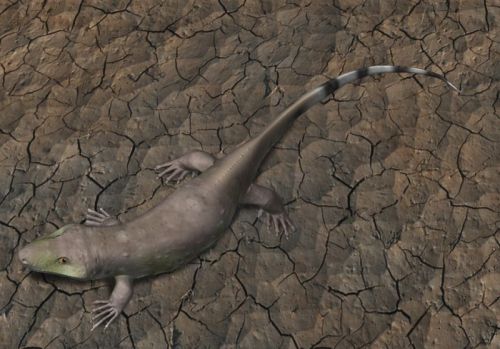
| Palaeos: |  |
Reptiliomorpha |
| The Vertebrates | Overview |
| Page Back | Unit Home | Unit Dendrogram | Unit References | Taxon Index | Page Next |
| Unit Back | Vertebrates Home | Vertebrate Dendrograms | Vertebrate References | Glossary | Unit Next |
|
Abbreviated Dendrogram
TETRAPODA |--TEMNOSPONDYLI `--+--LEPOSPONDYLI `--REPTILIOMORPHA |--Anthracosauroidea | `--+--Embolomeri | `--Chroniosuchia `--+--Gephyrostegidae `--Batrachosauria |--Seymouriamorpha `--+--Solenodonsaurus `--Cotylosauria |--Diadectomorpha `--AMNIOTA |
Contents
ReptiliomorphaEmbolomeri Chroniosuchia Gephyrostegidae Seymouriamorpha Diadectomorpha Dendrogram References |
 Tseajaia campi Vaughn 1964, an early Permian diadectomorph, length about 90cm. This was an animal on teh verge of becoming a reptile. The diadectomorphs, of which Tseajaia was a late but primitive representative, were animals that were very reptile like in structure and appearance, but probably were still physiologically amphibians, having to return to the water to lay their eggs. Life reconstruction, by Nobu Tamura . Wikipedia, GNU Free Documentation/Creative Commons Attribution |
Our subtitle here is the same as the title of Dr. Jenny Clack's recent book about the origin and early evolution of the Tetrapoda. The irony of Clack's title is that she has shown, rather convincingly, that none of the early tetrapods were likely to have been terrestrial to any marked degree. She argues, convincingly, that many of the critical "terrstrial" adaptations of the early tetrapods can just as easily be interpreted as adaptations to aquatic lifestyles. Elsewhwere, we have discussed that this point may have been overstated. The particular suite of adaptations we see in early tetrapods may have succeeded, not because they were aquatic adaptations, and not because they were terrestrial adaptations, but precisely because they were both. Thus, Clack's thesis is certainly valid to the extent it states that tetrapods were primitively not evolving toward terrestriality. Rather, they were becoming better and better amphibians.
The real turn to terrestriality begins here, with the Reptiliomorpha. We tentatively define this clade as one of the supporting stems of crown group Tetrapoda*. As a reminder, Tetrapoda* is defined (at various places in Palaeos, as dogs + frogs, princes + frogs, or Prof. Michael Coates + frogs. These are all equivalent definitions. Reptiliomorpha is then dogs (or princes, or Prof. Coates) > frogs.
In the not unlikely event that living amphibians are descended from temnospondyls, then the reptilomorphs will include a few more taxa but will otherwise change little. In terms of evolutionary grade, this section covers things from the anthracosaurs through the first steps of the amniote radiation. Temporally, this spans a very limited period. This whole process was probably compressed into about 30 million years, between the middle Mississippian and the middle of the Pennsylvanian. Yet, in that brief period, the tetrapods diversified from a rather homogeneous, if peculiar, bunch of air-breathing freshwater fishes into truly terrestrial amniotes, including anapsids (the turtle lineage), synapsids (the mammal lineage), and the true reptiles.
The critical points in this process involved the acquisition of a large group of amniote adaptations, most of which are listed here. ATW040821.
| Page Back | Unit Home | Page Top | Page Next |
checked ATW050530